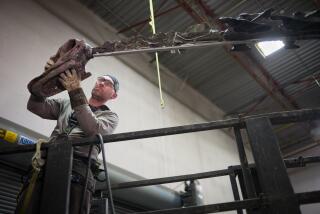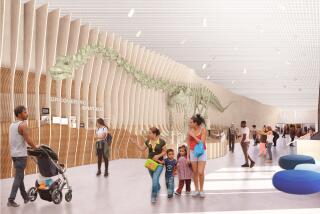Dinosaur Delights
- Share via
Here’s a summer vacation boredom buster: Send the kids outside and tell them to watch the sky for dinosaur descendants.
When they roll their eyes, insist that the dinosaur relatives will be along in a minute. And they will be, as soon as a few birds fly over. Birds evolved from small meat-eating dinosaurs, according to scientists at the American Museum of Natural History in New York.
Dinosaurs will be featured at several venues across the United States this summer, including the American Museum of Natural History in New York City, the Smithsonian’s National Museum of Natural History in Washington, the Field Museum of Natural History in Chicago and the Museum of the Rockies in Bozeman, Mont.
“Kids like dinosaurs because they’re so big,” said Dave Whitman, a spokesman for Utah’s Dinosaur National Monument. “Dinosaurs are never a hard sell to kids.”
On vacation, parents can encourage this interest by checking at local natural history museums when visiting a town to see if dinosaur workshops are planned. Parents can pack a few plastic or skeleton models that the kids can assemble during long car or plane trips.
Or, if in the East, they can visit the American Museum of Natural History, which opened two sensational new Dinosaur Halls last month.
The redesigned section includes the Hall of Saurischian Dinosaurs and the Hall of Ornithischian Dinosaurs, which were unveiled after more than $10 million in renovations and drew nearly 300,000 people during the first three weeks they were open.
No wonder. Anyone who visited New York as a child remembers the dusty dinosaur exhibits. They have now been remodeled into light-filled areas where visitors can get close to dinosaurs or find out more about them using computers stationed in the exhibit rooms. More specimens are on view here than anywhere else in the world, according to museum officials, who note that nearly 85% are real fossils, not reproductions.
My kids enjoyed the dinosaur nests and the 86-foot-long apatosaurus (formerly known as brontosaurus) that is shown with his tail lifted off the ground (not dragging) as scientists now think it was carried.
“Certainly, ‘Jurassic Park’ has helped, but there’s always been huge interest in dinosaurs,” said Melissa Posen, associate program director for the halls. “Kids love the idea that we’re not making this all up, that these creatures were alive at one time.”
For those driving between Yellowstone and Glacier national parks, the Museum of the Rockies is an ideal stop.
The museum’s exhibits tell the story of paleontologist Jack Horner’s 1979 discovery of North America’s first dinosaur eggs at what now is called Egg Mountain, near the Montana town of Choteau, about 200 miles northwest of the museum. Baby dinosaur skeletons, nests and thousands of other bones were subsequently found, demonstrating for the first time how some dinosaurs cared for their young. Dinosaur lovers can visit Egg Mountain themselves. There are free tours at 2 p.m. daily through mid-August.
Families with children over 10 years of age might want to attend daylong workshops in which participants dig for dinosaur bones. “We find bones every day,” said Museum of the Rockies acting education director Bonnie Sachatello-Sawyer.
Next summer, she said, a new 7,000-square-foot exhibit hall will open at the museum, showcasing its 40-foot-long Tyrannosaurus rex skeleton. (Call the Museum of the Rockies at 406-994-2251. Be forewarned that field programs can fill up six months in advance.)
Meanwhile, it seemed all of New York was off to greet the dinosaurs on a recent Friday, when my family and I braved crowds to visit the Dinosaur Halls. Despite the crowds, my children gave the exhibit a thumbs up. To help beat the crowds, museum officials recommend arriving when the museum opens at 10 a.m. or visiting on a Friday or Saturday evening, when the museum stays open until 8:45. (Call 212-769-5100 for information.)
For nearly 100 years, paleontologists at the American Museum of Natural History have been recognized for their efforts digging up dinosaur bones around the world. Their collection is said to be the largest in the world. That scholarship is evident in the new light-swept halls that will showcase the latest scientific research on dinosaurs, including the evolutionary relationship between them and birds.
My kids enjoyed the first dinosaur nests ever discovered, and the 86-foot-long apatosaurus (formerly known as brontosaurus) that shows his tail lifted off the ground--not dragging--as scientists now think it was carried.
No one will want to miss the Tyrannosaurus rex, newly mounted to reflect what scientists now believe, that he walked with his backbone horizontal to the ground, his tail in the air, rather than upright, as many of us were taught as kids.
Children will love the fossils they can feel at touch fossil stations. On display for touching are a dinosaur egg, a real triceratops horn, a bony scale from an armored dinosaur and teeth from meat- and plant-eating dinosaurs. They’ll also like the family exhibit labels that are identified by pictures of children and placed close to the ground. They answer questions kids are likely to ask.
Here’s one: Can scientists tell the difference between male and female dinosaurs? We can’t. We don’t even know their true colors or why they all died when they did.
*
Taking the Kids appears weekly.
More to Read
Sign up for The Wild
We’ll help you find the best places to hike, bike and run, as well as the perfect silent spots for meditation and yoga.
You may occasionally receive promotional content from the Los Angeles Times.






